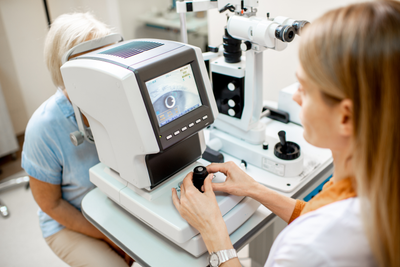Computer Eye Strain: Symptoms, Causes, and Prevention Strategies for the Tech-Savvy Generation

Understanding Digital Eye Strain
Definition and Prevalence
As someone who spends hours in front of a computer screen, I've come to understand that digital eye strain, also known as computer vision syndrome, is a common issue faced by many people. The average American worker spends around seven hours a day using digital devices, which can lead to a variety of vision-related problems. With the rise of mobile devices and increased computer use, the prevalence of digital eye strain has grown significantly over the years, impacting our overall eye health and well-being.
Computer eye strain occurs when our eyes focus on digital screens for extended periods without taking sufficient breaks. Environmental factors, such as overhead lighting and screen glare, can also contribute to the development of this condition. The visual demands of computer work can exceed our eyes' natural abilities, leading to discomfort and potential long-term issues if not addressed properly.
The Impact of Modern Lifestyle on Eye Health

Our modern lifestyle, with its heavy reliance on digital devices, has had a profound impact on our eye health. Prolonged computer use can lead to a range of symptoms, including eye discomfort, blurred vision, and dry eyes. The blue light emitted by digital screens can disrupt our natural sleep patterns, causing further strain on our eyes. Additionally, the increased use of contact lenses can contribute to dry eyes and exacerbate symptoms of digital eye strain.
With the rapid advancement of technology, it's more important than ever to be aware of the potential risks associated with digital device use. Taking steps to minimize the impact of digital screens on our eyes can help preserve our vision and maintain overall eye health.
Factors Contributing to Digital Eye Strain
There are several factors that contribute to the development of digital eye strain, one of which is the excessive use of digital devices. The short wavelength visible light emitted by screens can cause discomfort and strain on our eyes. Additionally, poor posture, uncorrected vision problems, and improper ergonomics can lead to neck and shoulder pain, which further exacerbate the symptoms of digital eye strain.
Other contributing factors include the use of contact lenses, improper use of eye drops, and insufficient blink frequency. It's essential to address these factors and implement preventative measures to minimize the impact of digital eye strain on our daily lives.
Recognizing the Symptoms
Physical Symptoms
Physical symptoms of digital eye strain can manifest in various ways, such as neck and shoulder pain, dry eyes, and eye discomfort. When working at a computer for extended periods, our eyes may not blink as frequently as they should, leading to a disruption in the tear film and causing dryness. Additionally, poor posture and improper ergonomics can cause strain on our neck and shoulders, leading to discomfort and further exacerbating the issue.
To combat these physical symptoms, it's crucial to take frequent breaks, maintain good posture, and adjust our computer workstations to promote comfort and reduce strain. Using artificial tears or eye drops can also help alleviate dry eyes and provide relief from eye discomfort.
Visual Symptoms
Visual symptoms of digital eye strain can include blurred vision, difficulty focusing, and increased sensitivity to light. These symptoms can be attributed to the constant need for our eyes to focus on digital screens and the exposure to blue light emitted by these devices. Uncorrected vision problems can also contribute to the development of visual symptoms associated with digital eye strain.
Addressing these visual symptoms may involve visiting an eye doctor for regular eye exams and ensuring that any vision problems are promptly addressed. Wearing glasses or updating your contact lens prescription can also help improve visual comfort while using digital devices.
Emotional and Cognitive Symptoms
Emotional and cognitive symptoms of digital eye strain can include feelings of frustration, irritability, and difficulty concentrating. The discomfort and vision problems associated with prolonged computer use can negatively impact our ability to focus and work efficiently, leading to a decline in productivity and overall well-being.
Implementing strategies to manage digital eye strain can help alleviate these emotional and cognitive symptoms, allowing us to regain focus, improve productivity, and enjoy a better quality of life both at work and outside of it.
Identifying the Causes
Excessive Screen Time
One of the primary causes of digital eye strain is excessive screen time. With the majority of our daily tasks revolving around the use of digital devices, our eyes are subjected to long hours of screen exposure, leading to eye strain and discomfort. Taking regular breaks and limiting our screen time can help reduce the risk of developing digital eye strain.
It's essential to be aware of the time we spend using digital devices and to create a balanced relationship with technology. This can involve setting boundaries for our screen time, engaging in activities that don't involve screens, and being mindful of our overall digital device usage.
Blue Light Exposure

Blue light exposure is another cause of digital eye strain. Digital screens emit short wavelength visible light, which can cause discomfort and strain on our eyes. Prolonged exposure to blue light can disrupt our natural sleep patterns and negatively impact our overall eye health.
To minimize blue light exposure, we can use blue light filters on our devices, wear computer glasses with anti-glare coatings, or adjust the screen brightness and contrast settings on our devices to reduce eye strain.
Improper Ergonomics and Viewing Distances
Improper ergonomics and viewing distances can also contribute to the development of digital eye strain. When our computer workstations are not set up correctly, it can result in poor posture, neck and shoulder pain, and eye strain. Ensuring that our screens are positioned at an appropriate distance and angle can help alleviate these issues.
Adjusting our workstations to promote comfort and reduce strain, such as positioning our screens at arm's length and eye level, can help prevent digital eye strain and its associated symptoms.
Uncorrected Vision Problems

Uncorrected vision problems are another cause of digital eye strain. When our vision is not adequately corrected, our eyes have to work harder to focus on digital screens, leading to eye fatigue and discomfort. Regular eye exams and addressing any vision issues can help prevent digital eye strain and improve our overall eye health.
Staying up to date with our eye doctor appointments and following up with any necessary vision correction, such as updating our glasses or contact lens prescription, can play a crucial role in managing digital eye strain.
Prevention Strategies
Implementing the 20-20-20 Rule
One effective prevention strategy for digital eye strain is implementing the 20-20-20 rule. This rule suggests taking a break every 20 minutes to look at something 20 feet away for 20 seconds. This simple technique allows our eyes to rest and refocus, reducing eye strain and discomfort associated with prolonged screen use.
Incorporating the 20-20-20 rule into our daily routine can help alleviate digital eye strain symptoms and promote better eye health. Taking regular breaks also provides an opportunity to stretch and adjust our posture, further reducing the risk of developing neck and shoulder pain.
Optimizing Screen Brightness and Contrast

Adjusting screen brightness and contrast settings on our digital devices can also help prevent digital eye strain. Ensuring that our screens are neither too bright nor too dim can reduce eye strain and improve visual comfort. Additionally, reducing screen glare and minimizing reflections can further alleviate eye discomfort.
Using a screen glare filter or adjusting ambient lighting, such as by using desk lamps or minimizing overhead fluorescent lighting, can help create a more comfortable viewing experience and reduce the risk of digital eye strain.
Adjusting Workstation Ergonomics
Proper workstation ergonomics play a crucial role in preventing digital eye strain. Adjusting our computer workstations to promote comfort and reduce strain can help alleviate eye discomfort and associated symptoms. This may involve positioning our screens at an appropriate distance and angle, ensuring that our chairs provide adequate support, and maintaining good posture throughout the day.
Additionally, using a document holder to position reading materials at eye level and taking frequent breaks to stretch and move around can further reduce the risk of developing digital eye strain and its associated symptoms.
Using Computer Glasses and Blue Light Filters

Wearing computer glasses or using blue light filters on our digital devices can help reduce blue light exposure and minimize the risk of digital eye strain. Computer glasses with anti-glare coatings can improve visual comfort while using digital devices, while blue light filters can help block harmful blue light emitted by screens.
Considering these preventative measures can be beneficial for individuals who spend a significant amount of time using digital devices, helping to maintain overall eye health and well-being.
Maintaining Eye Health in the Digital Age
Regular Eye Exams and Addressing Vision Issues
Regular eye exams are essential for maintaining eye health in the digital age. By visiting an eye doctor regularly, we can address any vision issues that may contribute to digital eye strain and ensure that our eyes are functioning optimally. Keeping up with our eye exams and addressing any necessary vision correction can play a crucial role in managing digital eye strain and improving overall eye health.
Additionally, staying informed about new solutions and advancements in eye care can help us adapt to the ever-evolving digital world and preserve our eye health.
Promoting a Healthy Lifestyle
Adopting a healthy lifestyle can also contribute to maintaining eye health in the digital age. This may involve engaging in regular physical activity, eating a balanced diet rich in nutrients that support eye health, and getting adequate sleep. A healthy lifestyle can help improve our overall well-being and reduce the risk of developing digital eye strain and other vision-related problems.
Furthermore, finding a balance between screen time and other activities can help promote a healthier relationship with technology and reduce the impact of digital devices on our eye health.
Creating a Balanced Relationship with Technology

Creating a balanced relationship with technology is essential for maintaining eye health in the digital age. By setting boundaries for our screen time and engaging in activities that don't involve digital devices, we can reduce our exposure to blue light and the strain on our eyes. Taking regular breaks, practicing the 20-20-20 rule, and finding a balance between work and leisure can help us manage digital eye strain and maintain overall eye health.
Additionally, staying mindful of our digital device usage and adjusting our habits as needed can help us create a more balanced and healthier relationship with technology, ultimately reducing the risk of developing digital eye strain and other related health issues.
Staying Informed and Adapting to New Solutions
Staying informed about the latest research, advancements, and solutions for maintaining eye health in the digital age is crucial. As technology continues to evolve, so do the potential risks and challenges associated with digital device use. By staying up-to-date on new developments and adapting to new solutions, we can proactively address the impact of digital devices on our eye health and well-being.
Embracing new technologies, such as blue light filters, computer glasses, and ergonomic tools, can help us create a more comfortable and healthier environment for our eyes. By staying informed and adapting to new solutions, we can better manage digital eye strain and maintain our eye health in an ever-evolving digital world.
A Brighter Outlook for Eye Health

As we navigate the digital age, it's essential to recognize the potential impact of digital devices on our eye health and take proactive steps to prevent and manage digital eye strain. By understanding the causes and symptoms of digital eye strain, implementing preventative measures, and maintaining a balanced relationship with technology, we can preserve our eye health and improve our overall well-being. Staying informed and adapting to new solutions will ensure a brighter outlook for our eye health in the constantly evolving digital landscape.
